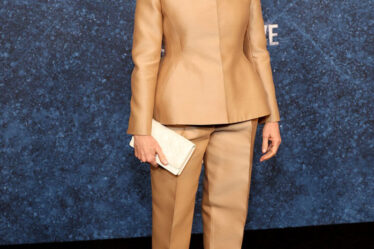
‘I think it’s so sexy to get dressed for a fiver,” says Miquita Oliver. She looks like a million dollars in an off-the-shoulder ivory bustier top with a cappuccino-froth of feathers below the neckline, and blue jeans that sit perfectly on her hips and graze the top of her kitten heels. It is note-perfect supermodel-at-an-afterparty cosplay – “my 90s Kate Moss look”, she calls it – but until two days ago, these clothes were buried among the mountains of cast-offs at Oxfam’s Yorkshire warehouse.
Oliver – television presenter, fashion week front-row fixture and now Oxfam ambassador – is a new kind of style icon, one who believes that secondhand clothes are not just better for the planet (although they are) or more affordable (ditto) but cooler – and sexier – than new clothes. Not second best for being secondhand, but more joyful for being pre-loved. So strongly does she believe this, in fact, that today she has taken up the challenge of styling her mum, TV chef Andi Oliver, and her 84-year-old grandmother, Maria, in clothes she found during a rummage through the Oxfam warehouse in Batley, to prove that secondhand is for everyone.
Secondhand September, now in its fourth year, is Oxfam’s annual campaign challenging shoppers to buy only secondhand clothes for a month. With September issues of glossy magazines pushing new trends and the high street aglow with boxfresh trends, the month has traditionally been the high-water mark of trend-led, disposable fashion – and nowhere more so than in the UK, where we buy more new clothes per person than anywhere else in Europe. It’s a habit that presents a calamitous threat to the future of our planet. One new pair of jeans is responsible for an estimated 16.2kg of CO2, equivalent to driving 58 miles in a car.
The latest in a stellar line of Oxfam fashion ambassadors who include Sienna Miller and Michaela Coel, Oliver has filled the rails of today’s studio with Oxfam treasures. “How good is this? And this!” she demands in triumph as she thrusts outfits into the arms of her mum and grandma and sends them off to get changed. Liberated from its matching jacket, a teal slub-silk dress that was once part of a staid suit, has become a chic party dress, teamed with a contrasting mule. (In the interests of full disclosure, it doesn’t hurt that Miquita has the gift of making everything she wears look like couture.)
She holds up a baby-blue Adidas fitted T-shirt alongside a boxy red miniskirt, and points out a pink kitten heel from Hobbs: “This one is my ‘Bob Marley’s girlfriend’ look”. Andi pounces on the most exuberant pieces with a magpie eye: a full circle skirt with jewel-toned ribbon trim is declared “very Joni Mitchell”, a huge hat is “1970s Cannes film festival, don’t you think?” Maria is more reticent, appraising each piece on the rail slowly, noting the quality fabrics, the pristine condition. “It is hard to believe what some people get rid of,” she says.
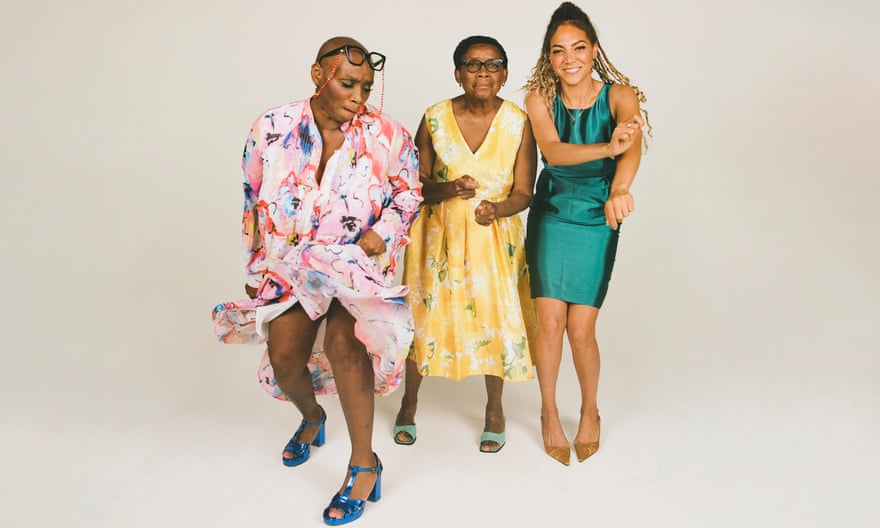
Maria has never done a photoshoot before, but as soon as the music is turned up she is a natural in front of the camera. In the tradition of families everywhere, the Olivers have landed on a playlist of classics. Sam Cooke’s Twistin’ the Night Away is followed by Al Green’s Take Me to the River, and Stevie Wonder’s For Once In My Life. Andi is big-hearted and beaming, flipping her skirts like a flamenco dancer while Maria clicks her fingers in a graceful, minimalist side-to-side shuffle. Miquita, willowy and slinky in her mini dress, seems to bridge her mum’s exuberance and her grandmother’s quiet self-possession.
Miquita, 38, has been on TV since she was 16, when she began presenting Channel 4’s cult Sunday morning pop culture show, Popworld, with Simon Amstell. Her style has evolved into a relaxed kind of polish: she has always loved a miniskirt, but she now teams it with a jacket or a neat sweater, rather than garish band T-shirt. She has an encyclopaedic knowledge of fashion references – a sweater is “very Celine 2012”, a dress is “Season 3 Carrie, falling in the pond when she’s surprised by Big” – and a lifelong love of secondhand shopping which has crystallised, in recent years, into a commitment to buying almost exclusively secondhand clothes. (She occasionally makes an exception for “a posh shoe.”)
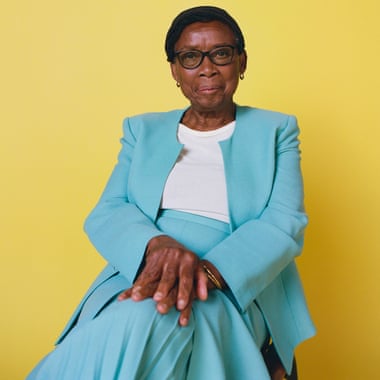
Still, today’s shoot was a shopping challenge. “I want to show that anyone can look and feel beautiful in secondhand clothes. My mum is a 58-year-old bald black woman who is on prime-time television, which is so inspiring to me. A lot of women feel like they aren’t visible – whether that’s women over 50, black women, women who don’t use their hair as their beauty – and so to see her develop her style as this joyous, celebratory thing has been banging.”
Miquita’s tactic, when she was rummaging through Oxfam bags looking for clothes for her mum, was to look for clothes that felt right in their shape and mood. Case in point: a white silk Jaeger full-skirted wrap dress – unworn, with the £399 price tag still attached. “My mum loves to spin and twirl. She’s a show off! I knew that dress would work for my mum because the moment I saw it, I thought of her.”
Andi is the odd one out in the Oliver style triumvirate. “Very gaudy”, is her mum’s assessment. “Glamorous. A bit of a hussy,” teases her daughter, and the three of them scream with laughter, thick as thieves. Maria and Miquita, 46 years apart in age, have “a kinship”, Miquita says, in style. “We like a jumper, a walking boot, a good trouser.” (Maria nods approvingly; Andi rolls her eyes in mock-despair.) Finding clothes for the senior Oliver matriarch was relatively straightforward, because “I was just like, what will I want to wear when I’m 80? But I had to look closely at everything – Nanny isn’t flamboyant like Mum, but she is careful and considered about what she wears. She sees the detail, you know?”
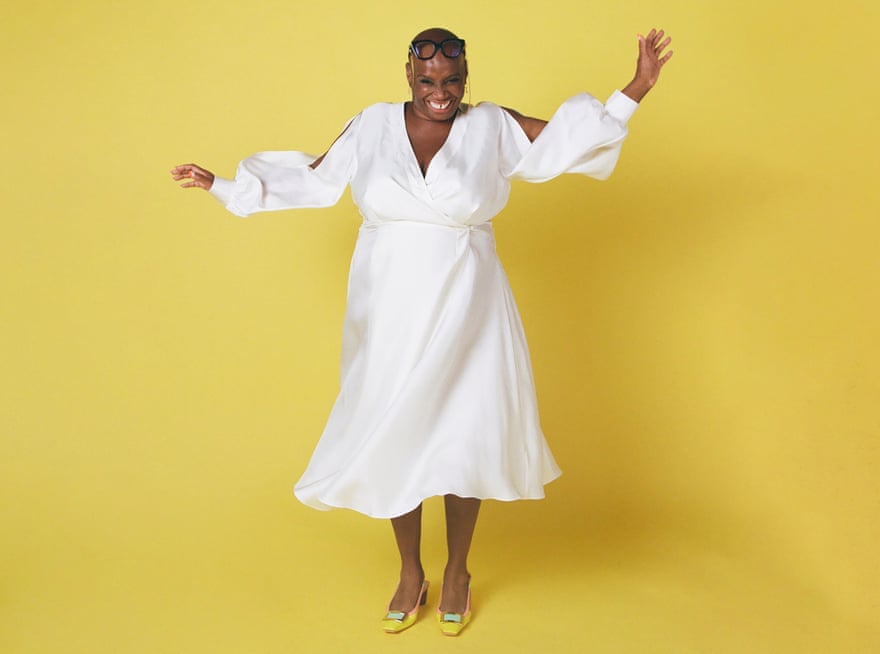
Maria appears in a three-piece ensemble in ivory silk which comprises a knee-length shift dress and matching collarless coat, with white-on-white flowers stitched into a long, slender scarf which matches the floral trim of the coat. “This is my favourite look of the day,” she says. “Very elegant.” Miquita declares that after today, she plans to have the dress shortened to mini length, ditch the coat, and wear the scarf tied in her hair. Maria says nothing, but strokes the tissue-fine silk of the scarf with a fondness that suggests her granddaughter may have a battle on her hands.
Maria Oliver grew up in the West Indies, with a mother who made all her clothes. “She had six boys, then six girls. With so many children, she couldn’t afford to buy new clothes, but she knew how to sew,” says Maria. She tailored suits for the boys, made formal dresses for the girls. (In family photos, Miquita says, “It looks like mini Armani and baby Chanel.”) Maria moved to England aged 19, eventually settling in Bury St Edmunds with her husband to raise her family. Andi was 14 when, in 1978, the Clash played the town – a gig that resulted in the local council banning live music from public venues for almost two decades. “I was like, OK! I get it! Now I understand life. So I became a punk.”
When she formed the band Rip Rig + Panic, two years later with her brother Sean and their friend Neneh Cherry, local charity shops provided the raw material for their stage outfits. “We’d buy old-lady-glamour things and chop them up, or wear men’s jackets and jumpers as dresses, with belts. Being a punk was about freedom, it wasn’t about wearing safety pins – although we were rubbish at sewing so finding ways to keep the clothes on your body once you’d cut them up was definitely an issue.” Once she bought leopard-print carpet fabric and made a pair of trousers, shaving them with a razor to take the nap off. “Those trousers were amazing,” she remembers with a nostalgic smile.
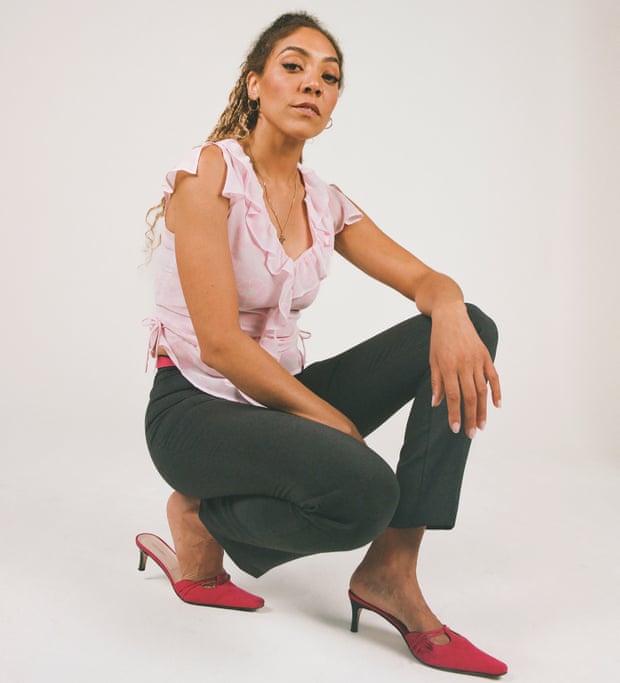
By the time Miquita was born, Andi was living near Portobello market in west London. “I was a single parent, I didn’t have lot of money. I bought a mixture of Ladybird clothes from Woolworths and secondhand things from the market. Portobello was incredible then, before it got posh.” These days she lives in Clapton, east London, “and the charity shops are brilliant. Although a lot of places are getting turned into coffee shops, which is a bit of a shame.”
Miquita grew up with little money, made a load of it in her early 20s, lost it all, and is now back on her feet and buying her first home. Of her free-spending early 20s, she has said that she “lived well, ridiculously well, but was just a bit too generous.” She spent £20,000 on her 21st birthday party, let her friends use her credit cards, and was declared bankrupt at 27 after failing to pay a £170,000 tax bill. “But whether I’ve had money or not, I’ve always preferred secondhand clothes,” she says. “When I was on Popworld the stylists would bring in Topshop or whatever, but I never felt as good as I did in something I’d found on Portobello market.”
Sometimes, secondhand means finding a designer-label bargain. For this shoot, she unearthed an immaculate Thierry Mugler skirt suit and a pristine Burberry knit polo dress in preppy navy and white, but she’s not really looking for designer names. “I don’t use the word vintage,” she says, “as that makes it sounds expensive. When you say ‘vintage’ it sounds like the doors are closed against you. I want to be like, I’m on TV wearing a skirt that cost £2 in a charity shop. That’s where the joy is.”
Maria is ready for her next closeup. She’s wearing a belted dress in a sunshine yellow floral. “I picked this one out myself,” she tells me. Miquita thinks it “very Talented Mr Ripley”, but Andi spots a different kind of fashion reference. “Do you know, that dress reminds me of pictures of you in Antigua when you were young,” she says, and her mum’s face lights up. This year, the Olivers have been reconnecting with their West Indian heritage, travelling to Antigua, Barbuda and Barbados for a two-part BBC Two series, The Caribbean with Andi and Miquita.
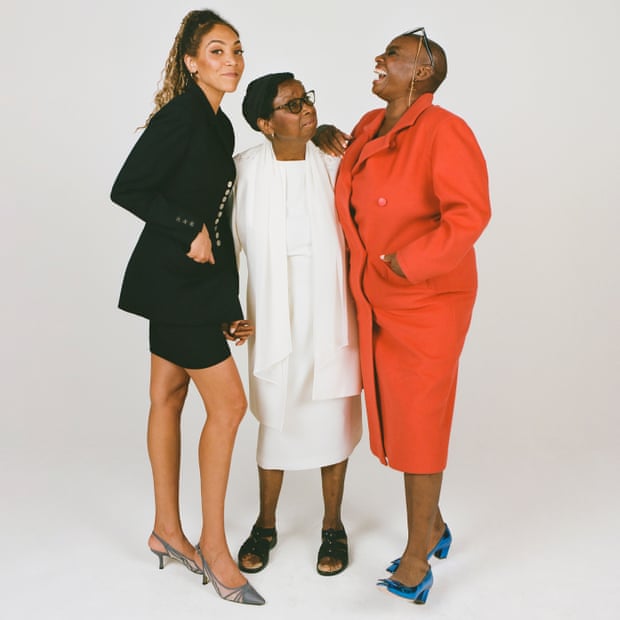
Since the trip, Miquita has started thinking about the roots of her own style in a different way. “Like, for instance, I’ve always loved a kitten heel. I think they are chic as fuck, and also I’m terrible at walking in high heels. But then I went to the Caribbean and looked around me and I was like, “Wait, this is basically what my aunties wore.” A kitten heel with a neat pair of trousers, that’s basically me. That’s the thing about style. It goes deeper than you realise.”
Secondhand September “shouldn’t be a lecture, or a test,” says Miquita. The trick to finding great clothes in charity shops, she says, is “to listen to your instinct. Have an open mind and see what speaks to you. I’ll walk into a shop and a stripe will catch my eye, or the shape of a collar. After a few times it gets easier to get in touch with what speaks to you. You need to look around and think: who am I? Which is a big question, obviously. Secondhand shops are the most fun way I know to find out.”
Don’t get hung up on size
“Think in terms of shape and cut, rather than looking for your size”, says Miquita. Sizing varies between brands and over time, so it’s much quicker to scan the rack for shapes that work for you – whether that’s tailored jackets, or floaty dresses – and narrow it down from there.
Embrace alterations
Miquita swears by the tailoring and repair expertise from the London alterations team Make Nu. But for a simple job like making a skirt shorter, try your local dry cleaner for a quick fix.
Channel your inner magpie
“Don’t walk in to the shop thinking you know exactly what you are looking for,” says Maria. “Be open to the colour or texture that catches your eye.”
Take your time
Charity shops can feel underwhelming when you first walk in. “Slow yourself down, open your eyes and really look,” says Miquita.
Don’t stop at clothes
“I’ve bought vases and shot glasses, tea sets, a whole dinner service,” says Andi. “And you can’t beat a secondhand book in an old edition with an inscription in the front.”
Take part in Oxfam’s Second Hand September and help protect our planet while freshening up your wardrobe


